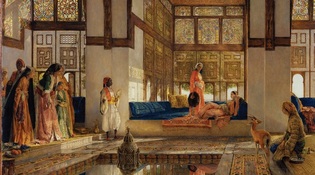 loading
loading
Arts & CultureObject LessonArt of the Empire Angus Trumble, Curator of Paintings and Sculpture at the Yale Center for British Art, is the author of A Brief History of the Smile.  Yale Center for British Art: Paul Mellon CollectionJohn Frederick Lewis made a thriving London career out of paintings like A Lady Receiving Visitors (The Reception); 1873, which purports to lift the veil on the harem. The painting is about two feet by two and a half feet. It is part of the Lure of the East exhibit, at the Center for British Art until April 27. View full imageThe painter John Frederick Lewis spent the entire decade of the 1840s in Cairo, where William Makepeace Thackeray found him living in the lap of luxury, like a "lotus-eater." There, Lewis created a formidable supply of drawings upon which to draw liberally for the rest of his successful career as a London-based painter of Levantine or "Orientalist" subjects. This painting, The Reception, is one of the cornerstones of Tate Britain's touring exhibition The Lure of the East. It was first exhibited at the Royal Academy of Arts, under the longer title A Lady Receiving Visitors: The Apartment is the Mandarah, the Lower Floor of the House, Cairo. It was executed in 1873, more than 20 years after Lewis's return to England. Every element of the composition, from the reclining figure (who was presumed to be the first wife of the harem); through the many fine details of pattern, texture and fretwork, glass, metalwork, and tiled decor; down to the pet gazelle -- which was known to be a favorite in well-to-do nineteenth-century Egyptian households -- works to create an impression of authenticity. Lewis seems to be lifting the veil of privacy that otherwise concealed from male eyes the feminine realm of the harem, and the aura of plausibility enables him to excite his English audience with its erotic suggestions of afternoon heat and languor. But in fact, the term mandarah, which is so specific and which Lewis took such care to fold into the original title of the picture, was misleading. The mandarah, on the first floor, was actually used to receive male visitors -- of whom there is no trace here. It was the so-called qa'a, upstairs, that was normally set aside for the women of the house. Lewis's painting, which purports to reveal the truth about the harem, actually takes considerable liberties with the facts, facts of which Lewis himself was well aware. To this extent it is entirely consistent with Britain's invariably proprietorial and frequently condescending attitude toward its rapidly accumulating colonial possessions all over the world.
The comment period has expired.
|
|